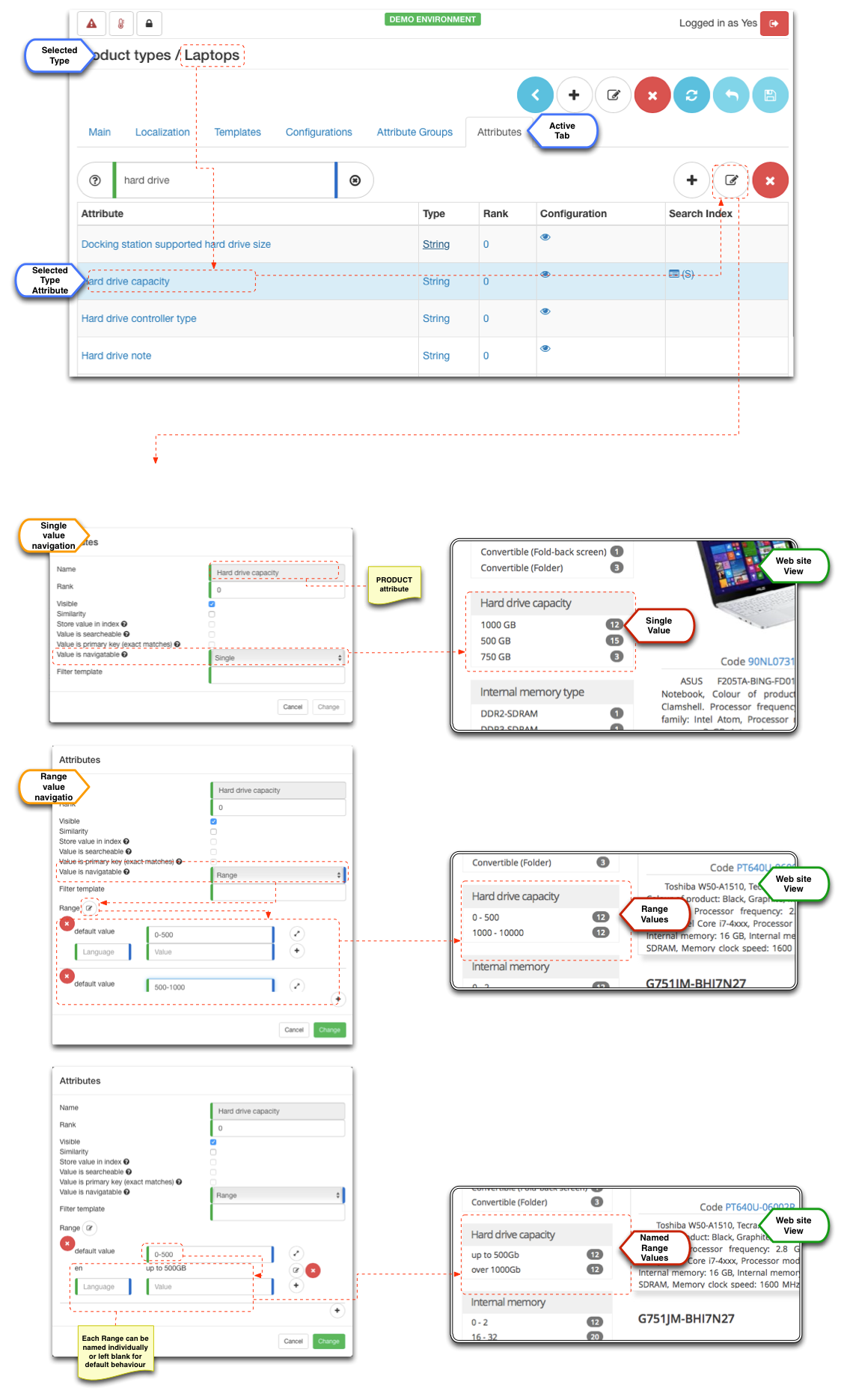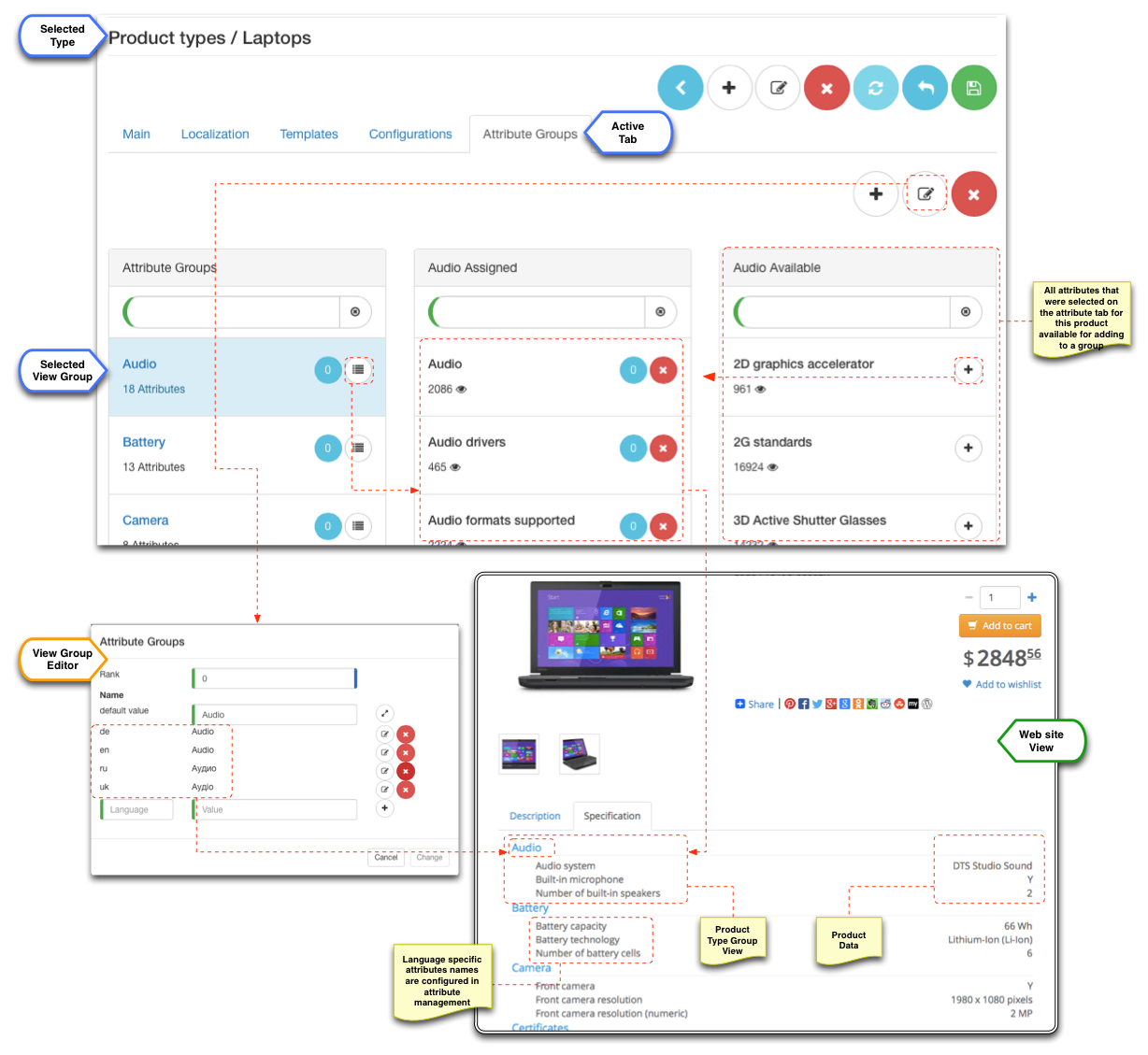Product types management
Product type definition provides a description of product attributes targeting aspects of:
- presentation - i.e. what details are relevant on product details and product comparison?
- search and navigation - i.e. which attributes are relevant for searching and which one are important enough to be part of navigation?
- internal information - i.e. supporting information to aid checkout and fulfilment processes and any other functional needs in custom implementation (e.g. themes templates and CMS dynamic content)
Customer Navigation Aspect
Product types are providing classification for products and as such might be useful for the customer as search criteria or means of navigation. All product types names are made available as a special navigatable attribute productType, which can be referenced from within Product type attributes itself. This is very powerful when depicting product types in a hierarchical form.
Consider the following use case when a shop specialising in fashion products has top level categories: "for women", "for men" and "for kids". It is possible to define an abstract product type for each of these categories and reference product type within its definition as a navigatable attribute. Each category will contain a multitude of products of different types such as "dresses", "tops", "shoes" etc. Therefore when navigating to category "for women" we will see an attribute navigation block which would list how many dresses, tops and shoes there allowing customers easily to navigate to desired kind of product and streamline the checkout process.
An example of this in our demo shop looks like this: when searching by tag we are able to see a product type navigation block and use it to navigate to the "type" of product we are interested in the most given whatever search criteria we have used prior getting to this page:
Templates
Templates configurations are used as means of extending the UI views for category lister and product details pages. By specifying a template in each of these input fields the platform when rendering the UI will attempt to use a variation of templates.
This creates flexible mechanism for theme framework to provide a different presentation layer that is unique to particular product type in order to increase customer conversion.
Configurations
| Flag | Intended purpose | Functional impact |
|---|---|---|
| Services | Defines a product which is a service, e.g. warranty, license or a subscription | |
| Collection | Defines a product which is a group of products/bundle | |
| Shippable | Defines a tangible product that is deliverable | |
| Downloadable | Defines a product that can be delivered via download link | |
| Digital | Defines a digital product that does not need a physical delivery | Used by default order splitting strategy to put these products into D4 (Electronic delivery group) |
Attributes, search and navigation
Product type can contain multitude of attributes from PRODUCT group, referred to as "product type attributes". Product type attributes provide a link between attribute definitions and the product type, and add semantic information to the data presentation functions such as search and navigation, sorting, comparison etc.
Adding attribute is a trivial task, which simply involves picking attribute from a PRODUCT group and setting visible and similarity flags and sorting rank. Search and navigation flags are inherited from the attribute definitions and cannot be changed from this editor. You can modify these from the attribute management section.
Visible allows to specify if attribute should be visible to customer (specifically in filters, product details and comparison pages)
Similarity flag reserved to identify similarity between products (not currently used by platform)
Rank can be used for specific sorting of the attributes. If rank for all attributes is the same then alphabetical sorting is applied.
Navigation blocks come in three flavours:
- Single - presenting list of unique attribute values that are applicable in current search, when selected applies AND condition thus reducing the result to single option
- Multi SaaS - similar to Single but allows multiple selection, when selected applies OR condition thus reducing the result but allowing additional filtering on the same attribute
- Range - numeric range criteria, when selected applies range condition, which can be presented as range values or have a human readable name as specified in range configuration
Non restrictive attribute set
Product type only suggests typical set of attributes that best describe product to the customer or will allow it to be searched for, however it does not restrict business user in terms of product data entry. It is a valid and supported use case to import more attribute values to the product than is defined by its product type. Additional attribute data will still be accessible via products editor "attributes" tab as any other attributes defined by the product type.
Product type view
Product type view refers to all product type view groups declared for a product type. Collectively these groups provide a complete view of the product from different angles such as design, features, technical parameters and specifications. Any number of view groups can be created for a product type.
Localisation of the name of the group follows the same procedure as any other language sensitive component. Localisation of the the attribute names within the group comes from PRODUCT attribute definition. Localisation of the values comes from the product attribute values directly, if the value type supports localisation, otherwise actual value is displayed.
Once the group is declared product type attributes can be assigned to it. Note that same attribute can be present in several groups if necessary and it is up to the business to decide what groups are applicable and what attributes should they contain. End result of this configuration can be seen on the product details page, namely product "Specification" tab or comparison page SaaS .
Note that in default theme view groups and attributes within them only appear if currently viewed product has values for those attributes. So there no tedious work having to align data across the whole product data set. Whatever data is in PIM will be presented to the customer, whatever is not there is skipped lest clutter the page.



